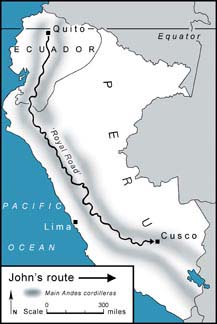
![]() Royal Road intro – First update – Previous update – Next update – Final update – Come to a talk!
Royal Road intro – First update – Previous update – Next update – Final update – Come to a talk!
This week I reached Yanahuanca in the Department of Cerro de Pasco, completing a 100-mile stretch of the Royal Road which was easily the finest so far. From deep limestone gorges to the high puna where only llamas survive, it gave me glimpses of life in a part of the Andes which has never seen a wheel, let alone a car. Houses were of rough adobe with straw roofs; and families spent much of their day on the open hillsides, tending flocks of sheep or llamas or working vast plots of potatoes. As in Inca times, this hardy native vegetable of the Andes is the main source of sustenance, and seems to thrive at the highest altitudes and in the thinnest of soils.
But my most vivid recollection is of dogs. These ferocious ‘perros pastorales’ are supposed to guard the flocks from rustlers, but most of them are so stupid they can’t tell a sheep rustler from a perfectly harmless gringo arriving in their midst. Sometimes they did hesitate for a moment in their frenzied attacks – but of course they don’t get much excitement or much to eat in their lives, so when these two basic necessities come rolling round the corner all wrapped up in a single tempting package their baser instincts just get the better of them.
Only once did I actually get bitten. Six of the beasts hurled themselves at me, snarling and baring their horrid yellow teeth, till their owner turned up and shooed them away. He looked at my shaking figure and chuckled. “You look a bit of a mess. Would you like some potatoes?”
He told me the dogs were needed because he and his neighbours were always stealing each other’s animals. “I don’t know why we do this,” he said, “it’s just a tradition.” After this I gave all four-legged creatures a wide berth. ‘Perros pastorales’ indeed. Makes them sound like poodles.
The only other drama was when I got stuck in a swamp. This was by a lake called Tambococha in a valley which I had to cross. The ooze spread for miles in both directions, so I chose what looked like the narrowest bit and waded in. It was rather scary to be up to my knees at one point, flailing about and sinking; but I managed to extricate myself somehow and emerged dripping and gooey on the other side. The Inca road crossed this marsh on a causeway which has sunk without trace.
To reach my next section I had to re-cross
the Cordillera Blanca, this time on top of a lorry. I camped near
the summit and enjoyed breakfast in several inches of snow. Walking
down the mountainside I came across some super specimens of Puya
Raimondi, the famous plant that lives for 100 years, then shoots
up a 30-foot flower and dies. They grow in just five valleys.
None were in flower sadly, but even a dead Puya Raimondi is something
special.
